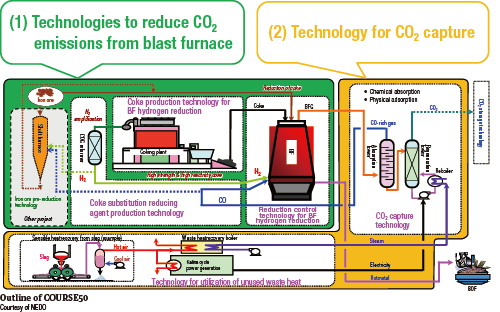Home > Highlighting JAPAN > Highlighting Japan September 2016 > Japan’s Fight Against Global Warming
Highlighting JAPAN

COURSE50: Breaking the CO2 Reduction Deadlock
In Japan, government and private sector partners are engaged in cooperative R&D to reduce the CO2 emissions produced in the manufacturing of iron and steel.
Carbon dioxide (CO2) emissions produced by the Japanese iron and steel industry account for 14% of Japan’s total CO2 emission footprint, and represent one of the country’s major emission sources. The major reason why the industry emits large volumes of CO2 is that the steelmaking process requires large amounts of coke. The iron ore that is the raw material for producing iron exists as iron oxide (iron bonded with oxygen). In order to produce iron from this iron ore, it is necessary to remove the oxygen from the ore via a process called reduction. To reduce the ore, manufacturers use coke, which is made by coal dry distillation to increase its carbon content. The iron ore and coke are fed into a blast furnace, where the coke is blasted with hot air in order to raise its temperature to a level that is high enough for producing carbon monoxide. At high temperature, this carbon monoxide combines readily with oxygen, acting as a reducing agent and removing the oxygen from the iron ore. However, because the carbon monoxide (CO) combines with the oxygen (O) (to form CO2), the process also produces large quantities of CO2.
“Since the time of the oil crisis in the 1970s, we have been advancing the introduction of energy-saving technologies and equipment,” says Shigeaki Tonomura of the Technical Planning Department at Nippon Steel & Sumitomo Metal Corporation (NSSMC). “As a result of this, energy saving in Japan’s iron and steel industry has advanced more than any other iron and steel industry in the world.”
The Japanese iron and steel industry is currently advancing a project named “Environmentally Harmonized Steelmaking Process Technology Development (COURSE50: CO2 Ultimate Reduction in Steelmaking process by innovative technology for cool Earth 50),” with the aim of achieving further mitigation in CO2 emissions towards 2050. The project is being driven forward by the New Energy and Industrial Technology Development Organization (NEDO) in the form of delegation to five companies: four iron and steel manufacturers (Kobe Steel, JFE Steel, NSSMC and Nisshin Steel) and one iron/steel-related engineering firm (Nippon Steel & Sumikin Engineering [NSENGI]).
“In recent years, mitigation of CO2 emissions has reached a plateau. Mitigation of CO2 emissions significantly using conventional methods is becoming difficult,” says Tonomura. “With COURSE50 we are aiming to develop innovative technologies to break that deadlock.”
Through the combination of two mitigation measures, COURSE50 aims to mitigate CO2 emissions by 30% in comparison with conventional methods. The first mitigation measure is to separate out and recover the CO2 from blast furnace gas and store it underground or under the sea. It is expected that CO2 emissions can be mitigated by around 20% using this technique.
The second mitigation measure is to use a method of reduction which uses hydrogen in place of some of the coke used in the conventional reduction process to reduce the iron ore. Whereas reduction using coke releases CO2, when hydrogen (H) is used it bonds with the oxygen (O) in the iron ore to produce water (H2O). Because the hydrogen used for the reduction is extracted from the gas released during the coking (coke production) process, this method effectively utilizes a source of hydrogen inherent to the steelmaking process. Through hydrogen reinforced reduction technology, manufacturers can mitigate CO2 emissions by a further 10%.
This March, the completion of a 12m3 experimental blast furnace at NSSMC’s Kimitsu Works was press-agented, and full-fledged testing began in June. Under COURSE50, the aim is to complete the first full-scale blast furnace by 2030, working under the premise that development of the requisite CO2 storage-related infrastructure and economic feasibility can be achieved in time.
“There are several hurdles ahead, including policy-related issues, but at this present time the schedule for the COURSE50 technology development is proceeding as planned,” says Tonomura.
The spread of energy-saving technologies developed and adapted for practical use in the Japanese iron and steel industry to other countries overseas is also progressing, achieving CO2 emission mitigation effects of over 53.4 million metric tons per year. If the practical realization of an innovative steelmaking process can be achieved through COURSE50, it is hoped that further contributions can be made towards the prevention of global warming.

© 2009 Cabinet Office, Government of Japan






